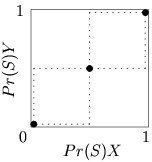 | ||
In game theory, coordination games are a class of games with multiple pure strategy Nash equilibria in which players choose the same or corresponding strategies.
Contents
- Examples
- Mixed strategy Nash equilibrium
- Coordination and equilibrium selection
- Experimental results
- References
If this game is a coordination game, then the following inequalities in payoffs hold for player 1 (rows): A > B, D > C, and for player 2 (columns): a > c, d > b. In this game the strategy profiles {Left, Up} and {Right, Down} are pure Nash equilibria, marked in gray. This setup can be extended for more than two strategies (strategies are usually sorted so that the Nash equilibria are in the diagonal from top left to bottom right), as well as for a game with more than two players.
Examples
A typical case for a coordination game is choosing the sides of the road upon which to drive, a social standard which can save lives if it is widely adhered to. In a simplified example, assume that two drivers meet on a narrow dirt road. Both have to swerve in order to avoid a head-on collision. If both execute the same swerving maneuver they will manage to pass each other, but if they choose differing maneuvers they will collide. In the payoff matrix in Fig. 2, successful passing is represented by a payoff of 10, and a collision by a payoff of 0.
In this case there are two pure Nash equilibria: either both swerve to the left, or both swerve to the right. In this example, it doesn't matter which side both players pick, as long as they both pick the same. Both solutions are Pareto efficient. This is not true for all coordination games, as the pure coordination game in Fig. 3 shows. Pure (or common interest) coordination is the game where the players both prefer the same Nash equilibrium outcome, here both players prefer partying over both staying at home to watch TV. The {Party, Party} outcome Pareto dominates the {Home, Home} outcome, just as both Pareto dominate the other two outcomes, {Party, Home} and {Home, Party}.
This is different in another type of coordination game commonly called battle of the sexes (or conflicting interest coordination), as seen in Fig. 4. In this game both players prefer engaging in the same activity over going alone, but their preferences differ over which activity they should engage in. Player 1 prefers that they both party while player 2 prefers that they both stay at home.
Finally, the stag hunt game in Fig. 5 shows a situation in which both players (hunters) can benefit if they cooperate (hunting a stag). However, cooperation might fail, because each hunter has an alternative which is safer because it does not require cooperation to succeed (hunting a hare). This example of the potential conflict between safety and social cooperation is originally due to Jean-Jacques Rousseau.
Mixed strategy Nash equilibrium
Coordination games also have mixed strategy Nash equilibria. In the generic coordination game above, a mixed Nash equilibrium is given by probabilities p = (d-b)/(a+d-b-c) to play Up and 1-p to play Down for player 1, and q = (D-C)/(A+D-B-C) to play Left and 1-q to play Right for player 2. Since d > b and d-b < a+d-b-c, p is always between zero and one, so existence is assured (similarly for q).
The reaction correspondences for 2×2 coordination games are shown in Fig. 6.
The pure Nash equilibria are the points in the bottom left and top right corners of the strategy space, while the mixed Nash equilibrium lies in the middle, at the intersection of the dashed lines.
Unlike the pure Nash equilibria, the mixed equilibrium is not an evolutionarily stable strategy (ESS). The mixed Nash equilibrium is also Pareto dominated by the two pure Nash equilibria (since the players will fail to coordinate with non-zero probability), a quandary that led Robert Aumann to propose the refinement of a correlated equilibrium.
Coordination and equilibrium selection
Games like the driving example above have illustrated the need for solution to coordination problems. Often we are confronted with circumstances where we must solve coordination problems without the ability to communicate with our partner. Many authors have suggested that particular equilibria are focal for one reason or another. For instance, some equilibria may give higher payoffs, be naturally more salient, may be more fair, or may be safer. Sometimes these refinements conflict, which makes certain coordination games especially complicated and interesting (e.g. the Stag hunt, in which {Stag,Stag} has higher payoffs, but {Hare,Hare} is safer).
Experimental results
Coordination games have been studied in laboratory experiments. One such experiment by Bortolotti, Devetag, and Ortmann was a weak-link experiment in which groups of individuals were asked to count and sort coins in an effort to measure the difference between individual and group incentives. Players in this experiment received a payoff based on their individual performance as well as a bonus that was weighted by the number of errors accumulated by their worst performing team member. Players also had the option to purchase more time, the cost of doing so was subtracted from their payoff. While groups initially failed to coordinate, researchers observed about 80% of the groups in the experiment coordinated successfully when the game was repeated.
When academics talk about coordination failure, most cases are that subjects achieve risk dominance rather than payoff dominance. Even when payoffs are better when players coordinate on one equilibrium, many times people will choose the less risky option where they are guaranteed some payoff and end up at an equilibrium that has sub-optimal payoff. Players are more likely to fail to coordinate on a riskier option when the difference between taking the risk or the safe option is smaller. The laboratory results suggest that coordination failure is a common phenomenon in the setting of order-statistic games and stag-hunt games.
